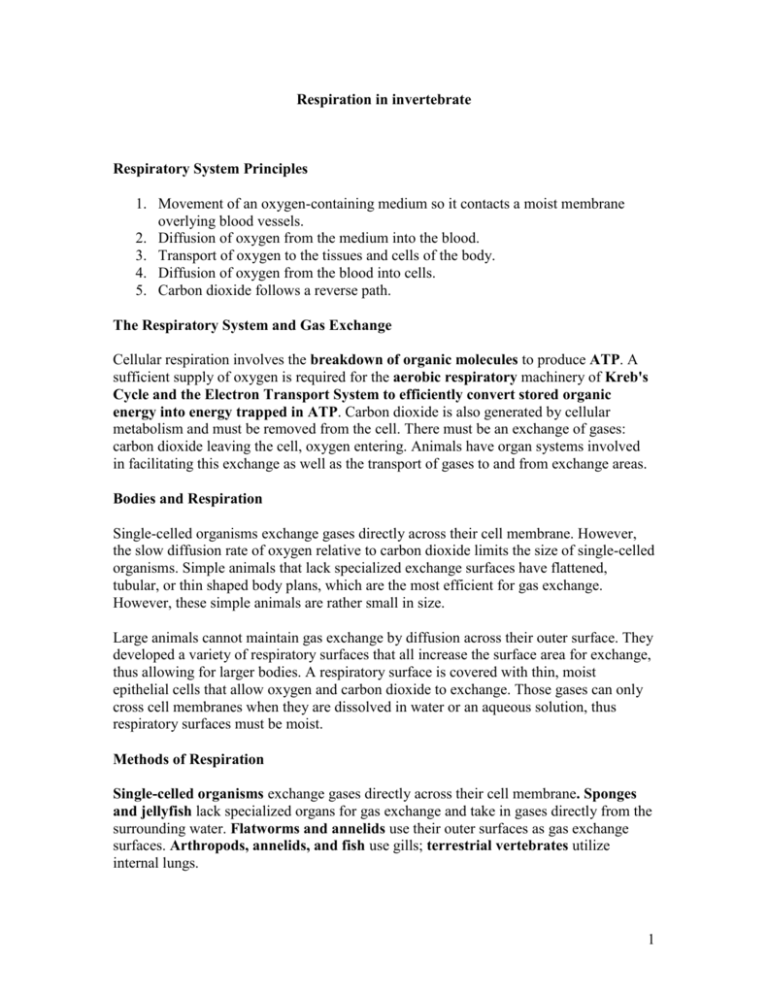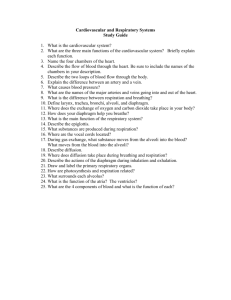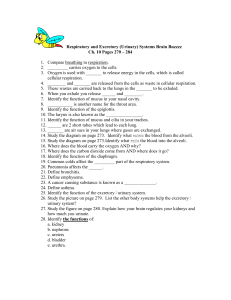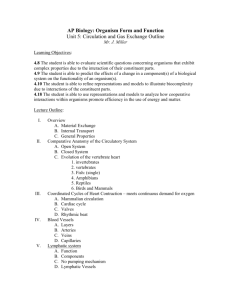Invertebrate Respiration: Gas Exchange Systems
advertisement

Respiration in invertebrate Respiratory System Principles 1. Movement of an oxygen-containing medium so it contacts a moist membrane overlying blood vessels. 2. Diffusion of oxygen from the medium into the blood. 3. Transport of oxygen to the tissues and cells of the body. 4. Diffusion of oxygen from the blood into cells. 5. Carbon dioxide follows a reverse path. The Respiratory System and Gas Exchange Cellular respiration involves the breakdown of organic molecules to produce ATP. A sufficient supply of oxygen is required for the aerobic respiratory machinery of Kreb's Cycle and the Electron Transport System to efficiently convert stored organic energy into energy trapped in ATP. Carbon dioxide is also generated by cellular metabolism and must be removed from the cell. There must be an exchange of gases: carbon dioxide leaving the cell, oxygen entering. Animals have organ systems involved in facilitating this exchange as well as the transport of gases to and from exchange areas. Bodies and Respiration Single-celled organisms exchange gases directly across their cell membrane. However, the slow diffusion rate of oxygen relative to carbon dioxide limits the size of single-celled organisms. Simple animals that lack specialized exchange surfaces have flattened, tubular, or thin shaped body plans, which are the most efficient for gas exchange. However, these simple animals are rather small in size. Large animals cannot maintain gas exchange by diffusion across their outer surface. They developed a variety of respiratory surfaces that all increase the surface area for exchange, thus allowing for larger bodies. A respiratory surface is covered with thin, moist epithelial cells that allow oxygen and carbon dioxide to exchange. Those gases can only cross cell membranes when they are dissolved in water or an aqueous solution, thus respiratory surfaces must be moist. Methods of Respiration Single-celled organisms exchange gases directly across their cell membrane. Sponges and jellyfish lack specialized organs for gas exchange and take in gases directly from the surrounding water. Flatworms and annelids use their outer surfaces as gas exchange surfaces. Arthropods, annelids, and fish use gills; terrestrial vertebrates utilize internal lungs. 1 Figure 1: showing booklung and tracheae The Body Surface (cutaneous respiration) Flatworms and annelids use their outer surfaces as gas exchange surfaces. Earthworms have a series of thin-walled blood vessels known as capillaries. Gas exchange occurs at capillaries located throughout the body as well as those in the respiratory surface. Gills Gills greatly increase the surface area for gas exchange. They occur in a variety of animal groups including arthropods (including some terrestrial crustaceans), annelids, fish, and amphibians. Gills typically are convoluted outgrowths containing blood vessels covered by a thin epithelial layer. Typically gills are organized into a series of plates and may be internal (as in crabs and fish) or external to the body (as in some amphibians). Gills are very efficient at removing oxygen from water: there is only 1/20 the amount of oxygen present in water as in the same volume of air. Water flows over gills in one direction while blood flows in the opposite direction through gill capillaries. This countercurrent flow maximizes oxygen transfer. Figure II 2 Tracheal Systems Many terrestrial animals have their respiratory surfaces inside the body and connected to the outside by a series of tubes. Tracheae are these tubes that carry air directly to cells for gas exchange. Spiracles are openings at the body surface that lead to tracheae that branch into smaller tubes known as tracheoles. The tubes branch repeatedly so that extremely fine tubules, tracheoles, reach the individual cells or small groups of cells inside the body. As you can imagine, the surface they provide for respiratory exchange is very large Body movements or contractions speed up the rate of diffusion of gases from tracheae into body cells. However, tracheae will not function well in animals whose body is longer than 5 cm. Figure III Respiratory system in an insect. FIGURE IV -- Generalized Diagram of Insect Tracheal System 3 FIGURE V -- Schematic Diagram of One Part of the Tracheal System Showing Relationships of Spiracle, Trachea and Tracheoles to the Body Wall and Internal Muscles. Lungs Lungs are ingrowths of the body wall and connect to the outside by as series of tubes and small openings. Lung breathing probably evolved about 400 million years ago. Lungs are not entirely the sole property of vertebrates, some terrestrial snails have a gas exchange structures similar to those in frogs. Arthropods have open circulatory systems with a prominent heart receiving blood from the hemocoel and pumping it into vessels for distribution to the body. Depending on the type of respiratory organ the arthropod possesses, the circulatory system may or may not be important in the transport of oxygen to the body tissues. Those animals in which the blood is not important for the circulation of respiratory gases (eg. insects) may have no respiratory pigment. protozoan, porifera and coelenterate ---Exchange of respiratory gases (CO 2 and O 2 ) by diffusion through body surface. platyhelminthes and nemahelminthes---Anaerobic respiration. Energy (ATP) produce by glycolysisGlycogen is broken down into volatile fatty aci, CO 2 and energy. CO 2 is released ot through body surface. 4 ANNELIDA --- respiratory organ is lacking. Gas exchange through skin (cutaneous respiration), gills (branchial respiration), parapodia. Parapodium is highly involved in (polychaetae) this process. Each parapodium has a capillary network and is richly supplied with blood. Body wall dorso-ventrally supplied with blood capillaries. Haemocoelomic fluid(blood) obtain oxygen through this network. Respiratory pigment haemoglobin enhance the intake of oxygen by haemocoelomic fluid. No special structure in Hirudinae and oligochaetae but by cutaneous respiration. ARTHROPODA -Aquatic arthropods generally have gills for respiration except for a few extremely small species in which there are no special respiratory structures. Terrestrial arthropods use several different respiratory organs, the most unique of which is the tracheal system. Two type of respiration in arthropods are Aquatic respiration and Aerial respiration. Aquatic respiration--- use the dissolved oxygen. Aquatic respiration is carried out by the following ways: Gills are delicate feather-like outgrowth of the thoracic appendages eg palaemon( prawn) and penaeus(scorpion), crab and tracheal gills are found in mayfly, damselfly and stonefly. Larvae have gills (blood gills and book gills) and crustacean through body surface. Gills are highly vascularised. Aerial respiration: utilizes the oxygen from the air. This mode found in terrestrial arthopods. Following are the aerial respiratory organs. a. Tracheal system ----mostly found insects, cetipedes , millipedes and many arachnids. b. Book lung ----- scorpion. (Highly vascularised chamber) c. simple lung----- terrestrial coconut crab d. Air tube-----Terrestrial crustacean. MOLLUSCA—Mollusca lead different modes of life. There are terrestrial (aerial respiration), aquatic (aquatic respiration) and amphibious mollusk (aerial and aquatic respiration). Molluscs respire through the following organs: Skin and mantle Ctenidia Pulmonary sac or lungs Trachea. Body surface Skin and mantle Skin and mantle are richly supplied with blood vessels.if skin is used for respiration is called cutaneous respiration and if mantle is used for respiration is called mantle of pallial respiration. Eg. Aplysia, Dentalium etc. Ctenidia 5 Ctenidia are the comb like outgrowth of the body surface or mantle. They are also called branchia or gill. Ctenidial respiration are found in chiton gastropods, plecypods, cephalopods. Ctenidium has central axis lamellae or filament. Entire gills surrounded by the cilia Pulmonary sac or lungs Pulmonary or lung respiration is present in both terrestrial and amphibious. Respiration is called pulmonary or aerial respiration. Pulmonary sac is bag like structure formed by the mantle. Hang from the roof of the mantle cavity. Trachea. It is a peaculiar features for some pulmonate molluscs. Some pulmonate mollusks gives of air breathing tubes called tracheae. Body surface It is alternative means to other form of respiration Some mollusks also used its integument for respiration called cutaneous respiration. ECHINODERMATA—respiration is carried out by thousand of dermal branchia or papulae. Dermal branchia are transparaent outgrowth on the skin, present on the aboral surface projecting through minute opening. Their cavities are in continuous with the coelom and they are covered by cilia. Dissolved O2 is extracted in the dermal papulae then diffuse into coelom. Gases exchange take place through thin wall of tube foot. Exchange of gases take place between the water and coelomic fluid. Generalization of respiration in invertebrate 1. Direct diffusion of gases to lung, gill and dermal papulae. 2. No respiratory organ in lower but higher has complex structure for respiration 3. Direct absorption of o2 but in higher o2 absorbed into coelomic fluid then distributed to the various tissue. 4. Aquatic take dissolve o2 but higher either dissolved o2 or o2 directly from air. 5. Single respiratory organ higher more than one respiratory organ What is the adaptive significance of the difference in the respiratory organ structure between organisms living in terrestrial versus aquatic environments? A surface that absorbs oxygen must be kept wet. This is not a problem for aquatic organisms as they are surrounded by water. But terrestrial organisms would lose large amounts of water to the dry air via evaporation from their respiratory surfaces. Therefore most terrestrial animals have their respiratory surfaces recessed deep inside the body to minimize the loss of water through evaporation. 6 Hard exoskeleton system (arthropods) and scale in reptile are the clear examples to minimize the loss of water freely References: Prasad, S.N. (1980). Life of Invertebrates. New Delhi: Vikas Publishing House. Pvt. Ltd. Armugum N.. (2004). A text book of invertebrate. Sara publication, new Delhi Taylor D.J., Grea N.P.O., Stout G.W., (1998). Biological Science, Cambridge University Press, U.K. 7









